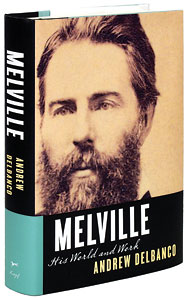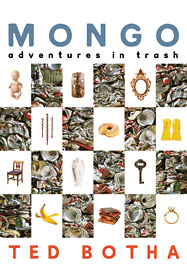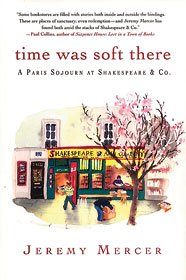Book Reviews
Melville

His World and Work
By Andrew Delbanco
New York: Knopf, 2005
415 pages. $30.00
ISBN 0375403140
Though Melville had been born and died in the
nineteenth century, Moby-Dick was the work of a twentieth-century
imagination
Literary biography is a mongrel genre, mixing
historical biography with literary criticism. Mediocre literary biographies
merely recycle fact and gossip about the author but offer no insight
about how their works were written and received, and why they continue
to endure. Andrew Delbanco’s Melville: His World and Work belongs
among the superlative breed of biography. It’s an outstanding
reappraisal of Melville, a reminder of his importance in American literature
and his relevance in our time.
When Melville died in New York City in 1891,
many of his contemporaries were surprised to see his obituary—they
thought he had died long before. After the Civil War and the commercial
and critical failure of Moby-Dick, Melville stopped writing
for publication. Of his seventy-two years, Delbanco notes, only twelve
were devoted to writing prose that was published in his lifetime.
Melville was born in 1819 in a newborn nation.
Giants such as Adams and Jefferson were still alive, the nation’s
economy was mainly agrarian, and slavery flourished. “During
Melville’s childhood,” Delbanco writes, “the rhythm
of American life was closer to medieval than to modern, but by the
time he grew old, he was living in a world that was recognizably our
own.” American literature, as embodied by Hawthorne and Emerson,
was also coming into its own during Melville’s adolescence.
Melville spent only three years on the high
seas—one year sailing to London and back, and another two in
the South Pacific and Hawaii. These voyages provided the content of
his earliest and most successful books, Typee and Omoo.
He planned to make a comfortable living as a professional writer, married,
and moved between Arrowhead, his family estate in western Massachusetts,
and the bursting metropolis of New York City.
Delbanco believes New York City played a larger
role in Melville’s life than many critics have acknowledged. “I
have swam through libraries,” Melville wrote, absorbing the works
of great European authors in the city’s private and society libraries.
His middle-period novels—Mardi, White-Jacket and Redburn—reflected
these influences and showed maturity, tackling social, political, and
philosophical issues. Most of his characters were drawn from urban
landscapes, not from his maritime experiences. Melville once observed, “Where
does any novelist pick up any character? For the most part, in town….
Every great town is a kind of man-show, where the novelist goes for
his stock.”
Everything was a prelude to the book he began
writing in 1850, “a strange sort of book” about a whaling
voyage. Delbanco makes a convincing argument that Moby-Dick was
the first modern American novel: “a young man’s coming-of-age
story, an encyclopedic inventory of facts and myths about whales, a
concatenation of romance, philosophy, natural history…. It was
also an audacious attempt, long before Freud and his modernist followers,
to represent in words the unconscious as well as the conscious processes
of the human mind itself.”
“And what of the man at the helm?” Delbanco
asks. Ahab is one of the most original characters in the history of
literature. He is the first appearance in literature of the modern
demagogue, “a prophetic mirror in which every generation of new
readers has seen reflected the political demagogues of its own times.”
Melville’s achievement came as his reputation
plummeted. The books from his middle period sold poorly. Readers wanted
the light-hearted adventure of the South Pacific found in his earlier
works, not allegorical epics about whale hunting. Many unsold copies
of the first U.S. edition of Moby-Dick were remaindered and
then lost to a fire in the publisher’s warehouse. Melville resorted
to magazine writing, living off the largesse of his in-laws, and working
as a New York customs house inspector for the last decades of his life
His personal life spiraled downward, along
with his writing career. He was moody in temperament, capable of enthusiasm
and energy, but prone to sudden downswings and withdrawals. These outbursts
alienated his wife and four children, especially his sons. Melville
would suffer the ghastly fate of outliving both his boys: Malcolm,
who committed suicide at eighteen; and Stanwix, who died in poverty
at thirty-five.
In this dark period, Melville achieved artistic
triumph. He published two of the greatest short stories in the English
language. “Bartleby the Scrivener,” Delbanco believes,
anticipates Kafka and existentialist literature by decades, grappling
with an un-resolvable tension between “the moral truth that we
owe our fellow human beings our faith and love” and “the
psychological and social truth that sympathy and benevolence have their
limits.” In his 1855 novella Benito Cereno, Melville
explores race and slavery by inverting the relationship between a Spanish
slave-ship captain and his African cargo.
Melville also wrote one last tale, left unfinished
and orphaned when he died. Discovered in a tin breadbox, Billy Budd,
Sailor was published in 1924, three decades after Melville’s
death. Twentieth-century writers such as E. M. Forster, Albert Camus,
and Thomas Mann regarded Billy Budd as Melville’s masterwork,
one of the most beautiful stories ever written. Generations of readers
have been touched by the doom of the Christ-like Billy, but for Melville,
Billy’s death is the inevitable consequence of the conflict between
society’s laws and natural justice, between the individual and
society.
Delbanco’s writing is blessedly free
from academic theory, and Melville is good biography and great
literary history.
Pasco Gasbarro is a book-review editor for this
magazine.
 Adventures in Trash
Adventures in Trash
By Ted Botha
New York: Bloomsbury, 2004
243 pages. $23.95
ISBN: 1582344523
According to Cassell’s Dictionary of
Slang, the word mongo was coined in New York in the 1980s.
It refers to trash, or more specifically, to treasure found in trash:
books, artifacts, furniture, even food. Ted Botha’s book explores
a whole culture, and various subcultures, that revolve around mongo.
Those obsessed with mongo often live on the
margins, sometimes by choice, sometimes by misfortune. The “canner” who
collects aluminum cans and glass bottles out of others’ garbage
bins for recycling, says Botha, is looking for mongo, as is the old
woman driving around the city, examining discarded and often broken
furniture on the sidewalk. They may be unemployed, addicts, or psychologically
disturbed; or they may be quiet citizens from the suburbs, enthralled
by the quest.
Botha classifies mongo collectors into different
types. “Pack rats” scour and accumulate for accumulation’s
sake. “Survivalists” look for high-quality mongo, like
used bed sheets rejected by wealthy Long Island households that can
be resold at the flea markets and sidewalk sales of Manhattan. “Anarchists” live
off the excess of restaurants and groceries, scavenging food from cartons
and garbage bins. They’re usually younger people who are involved
in anticonsumer and antiglobalization movements and subsist in the
precious few low-rent spaces left in Manhattan. “Visionaries” assemble
street-found mongo into ingenious works of art and interior décor
that belies their trashy origins.
Most book collectors have seen the eccentric
and disheveled devotees of mongo who lurk at the edge of the book trade
and salvage treasures, which end up on the shelves of more respectable
dealers and in private and institutional libraries. Botha’s chapter “The
Dealer” profiles Steven, a street bookseller whose stock consists
of discarded books and magazines found among the garbage of museums,
luxury apartment buildings, estate sales, and failed stores. He makes
remarkable finds and lives by a code of rules that exemplifies guerilla
bookselling, such as “Good books can turn up where you least
expect them” and “Time spent looking for the right buyer
could be worth a lot of money.” Some of these rules also reflect
the hard life of mongo collectors existing on the edge of society: “Never
get too attached to a book, or for that matter, to anything” and “Most
people think that if you collect off the sidewalk, you’re a bum.”
There are profound characters here, and Botha
is sympathetic to many of his subjects, but he doesn’t dig deep.
An admitted mongo aficionado, he’s more interested in the uses
of mongo—especially for art and interior design—than the
stories behind the people who collect it.
Pasco Gasbarro
Time was Soft There
 A Paris Sojourn at Shakespeare & Co.
A Paris Sojourn at Shakespeare & Co.
By Jeremy Mercer
New York: St. Martin’s Press, 2005
262 pages. $23.95
ISBN 0312347391
Time Was Soft There pleasantly surprised
me, as much as life surprised its author. Mercer, who started his career
as a journalist in Canada, found himself under a vendetta from a thug
whose crimes he had reported. He fled to Paris and, not unlike scores
of writers and artists who make a pilgrimage to the city, found himself
out of work and homeless. Running out of money, he was offered a bed
and a job by George Whitman, the proprietor of Shakespeare & Co.,
the legendary bookstore on the Left Bank. Mercer, who has a journalist’s
crisp style and a good eye for human details, recognizes the real story
is Whitman’s.
Whitman opened for business in 1951 and sometime
later took the name of Sylvia Beach’s Paris store, which had
played host to a bevy of now-famous writers between the world wars.
For fifty years he has hosted authors and artists (offering them a
bowl of soup and a place to sleep), promoted promising careers, and
instigated various causes liberal and profane. The list of writers
who visited and hung out at Shakespeare & Co. is a Who’s Who of
twentieth century literary history: Henry Miller, Anaïs Nin, Richard
Wright, the Beat writers, the Paris Review crowd, and Samuel
Beckett, among others. Whitman says he and Beckett mostly sat and stared
at each other.
Mercer worked in Shakespeare & Co. for
nearly a year, becoming enmeshed in the egos and eccentricities of
this bohemian community, which harkens back to an earlier age of bookselling. “Dude,
Shakespeare and Company doesn’t even have a telephone,” his
colleagues inform him. “Of course we don’t take credit
cards.”
The book’s strength is its two main characters,
the store and its owner, and the book is best when it stays inside
the shop. Whitman’s motto is “Take what you need, and give
what you can.” His aesthetic sense is uncanny, his business sense
scatterbrained. After losing a stash of two hundred francs to a nest
of hungry rodents, he muses, “At least it’s not the books.” Is
Shakespeare & Co. really a business, Mercer wonders, and Whitman
replies, “I run a socialist Utopia that masquerades as a bookstore.”
Pasco Gasbarro

 Adventures in Trash
Adventures in Trash A Paris Sojourn at Shakespeare & Co.
A Paris Sojourn at Shakespeare & Co.